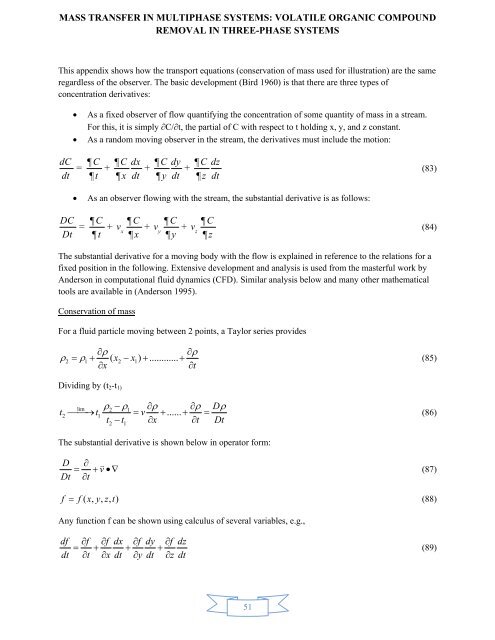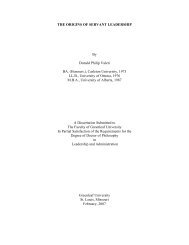mass transfer in multiphase systems - Greenleaf University
mass transfer in multiphase systems - Greenleaf University
mass transfer in multiphase systems - Greenleaf University
You also want an ePaper? Increase the reach of your titles
YUMPU automatically turns print PDFs into web optimized ePapers that Google loves.
MASS TRANSFER IN MULTIPHASE SYSTEMS: VOLATILE ORGANIC COMPOUND<br />
REMOVAL IN THREE-PHASE SYSTEMS<br />
This appendix shows how the transport equations (conservation of <strong>mass</strong> used for illustration) are the same<br />
regardless of the observer. The basic development (Bird 1960) is that there are three types of<br />
concentration derivatives:<br />
<br />
<br />
As a fixed observer of flow quantify<strong>in</strong>g the concentration of some quantity of <strong>mass</strong> <strong>in</strong> a stream.<br />
For this, it is simply C/t, the partial of C with respect to t hold<strong>in</strong>g x, y, and z constant.<br />
As a random mov<strong>in</strong>g observer <strong>in</strong> the stream, the derivatives must <strong>in</strong>clude the motion:<br />
dC C C dx C dy C dz<br />
= + + +<br />
dt t x dt y dt z dt<br />
(83)<br />
<br />
As an observer flow<strong>in</strong>g with the stream, the substantial derivative is as follows:<br />
DC C C C C<br />
= + v + v + v<br />
x y z<br />
Dt t x y z<br />
(84)<br />
The substantial derivative for a mov<strong>in</strong>g body with the flow is expla<strong>in</strong>ed <strong>in</strong> reference to the relations for a<br />
fixed position <strong>in</strong> the follow<strong>in</strong>g. Extensive development and analysis is used from the masterful work by<br />
Anderson <strong>in</strong> computational fluid dynamics (CFD). Similar analysis below and many other mathematical<br />
tools are available <strong>in</strong> (Anderson 1995).<br />
Conservation of <strong>mass</strong><br />
For a fluid particle mov<strong>in</strong>g between 2 po<strong>in</strong>ts, a Taylor series provides<br />
<br />
<br />
2 1 ( x2 x1) ............<br />
<br />
x<br />
t<br />
(85)<br />
Divid<strong>in</strong>g by (t 2 -t 1)<br />
D<br />
t t v<br />
......<br />
<br />
t t x t Dt<br />
lim 2 1<br />
2 1<br />
2 1<br />
(86)<br />
The substantial derivative is shown below <strong>in</strong> operator form:<br />
D<br />
Dt<br />
<br />
v<br />
<br />
t<br />
(87)<br />
f<br />
f ( x, y, z, t)<br />
(88)<br />
Any function f can be shown us<strong>in</strong>g calculus of several variables, e.g.,<br />
df f f dx f dy f dz<br />
<br />
dt t x dt y dt z dt<br />
(89)<br />
51



